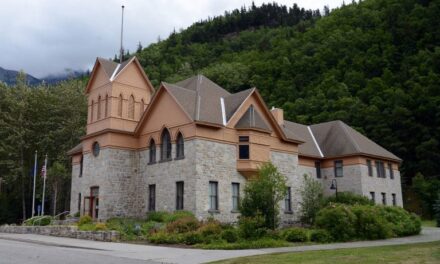
Haines Avalanche Center Director Erik Stevens observed the results of a large avalanche cycle in aerial surveys Tuesday. (Photo courtesy of Erik Stevens)
Last weekend, the Haines Avalanche Center issued warnings of unusually dangerous backcountry snow conditions. Avalanche danger ranged from high to extreme, and users were warned not to venture into dangerous terrain. But, the snowpack is starting to stabilize.
“Extreme is something that we reserve for pretty serious situations,” says Haines Avalanche Center Director Erik Stevens. “I think the last time we issued extreme – I think we did once last year. And I believe this is the third time we’ve gone to extreme in the last eight years I’ve been forecasting here. It’s not very often at all.”
And, what exactly does that mean?
“The definition of extreme is widespread avalanche activity is expected,” says Stevens. “Or certain.”
Basically, don’t even go there.
“Yeah there’s really no reason to be out in the backcountry in any kind of avalanche terrain in those kinds of conditions,” says Stevens.
We’re on our way, but not quite out of the woods yet.
According to the avalanche center, danger remains considerable throughout the backcountry.
“It’s definitely not perfectly safe now but we’re on the tail end,” says Stevens. “Things are getting better. Looking out the window, it’s still raining a little bit. But hopefully this rain will taper off soon. Once this rain stops and the temperature starts to drop, that will make a big difference, things will stabilize pretty fast.”
Stevens says users still need to be particularly cautious.
“We’re still forecasting considerable danger which means human triggered avalanches are still likely,” says Stevens. “So people should still be really careful in the backcountry. The snowpack is soaking wet right now. Things are still moving around a little bit. But the bulk of the natural avalanche cycle has passed I think.”
According to Stevens, what happened last weekend was a large avalanche cycle.
“Avalanche cycles happen periodically,” says Stevens. “Some are bigger than others. This weekend especially was particularly dangerous to humans. Because there was a lot of powder. The skiing was good, it was really good. People were going out skiing.”
There weren’t any reported incidents of dangerous human-involved avalanches – but there were a lot of avalanches. Stevens did an aerial survey of the Chilkat Valley on Tuesday.
“Pretty much everything slid out over that period,” says Stevens.
Still, he cautions not everything slid – there are still dangerous slopes in the mix.
In the short-term, things are likely to improve.
“What we’re looking at the next couple of days is clearing weather – good weather, it looks like it’s going to be clear, pretty calm, pretty sunny, and the temperatures are going to be dropping which is really key for the avalanche danger,” says Stevens. “Once the snowpack re-freezes, it should lock up pretty good. So we’re still waiting for that to happen but hopefully over the next couple of days things will be really calming down.”
For more information on forecasts – to read or record observations, visit alaskasnow.org.








